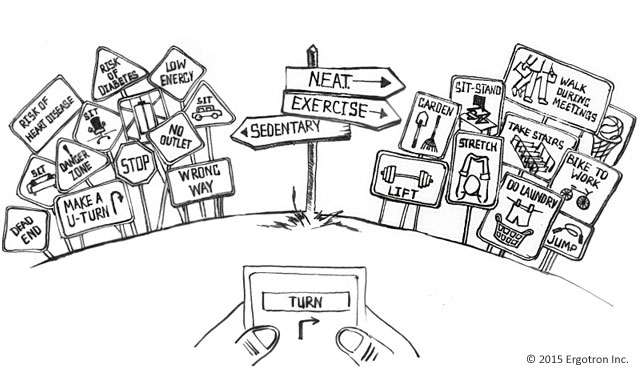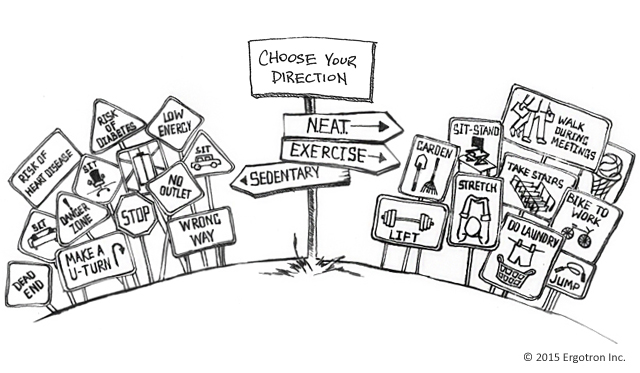
“Obviously there should be a slow ramp up from 100% sitting to a ratio between sitting and standing. What is the optimal ratio? How long should the ramp up be (days, weeks, months)?” ~ Maurico C.
Great question, Maurico, and an important one. No one has come up with the hard and fast rule yet, but many of the world’s leading researchers are weighing into the debate. From our perspective, part of this answer depends on how comfortable you are making changes and how hunched and crunched from prolonged sitting you are right now.
Good rule of thumb?
Change postures every 30 minutes. This seems to be an optimal length of time to stand before your body becomes too static, or to sit before your body overloads. This doesn’t work for everyone and some of it depends on the approach you are taking to standing and moving more in the first place. A first step might be to set some goals. If you did the calculations, you may discover you are sitting more than 14 hours during your day. It is an unrealistic goal to cut that number in half in the first week. It is more realistic to start sitting one hour less per day. This gives you some choice about where you begin and helps you achieve success over time as well.
Break up that sedentary slump.
Focus on the most sedentary times of your day. If you are tuning into your internal radio station, more than likely you’ve been hearing some grumbling from that hour of the show…Man, my back feels stiff right now…or…wait a minute, where did that pain come from? If you haven’t been hearing anything, turn the volume up. Your body will tell you how much it can handle. Do you feel achy or fatigued? Is there any pain? Is it telling you that you feel good, maybe even energized and focused when standing? These are your clues about when to change your position.
You may experience some discomfort at the beginning when switching to sit-stand computing. Maybe after 10 minutes of standing, maybe after an hour. The key is to listen to the message and change postures when you hear it. You will hear it, whether seated or standing. Your body is that good.
One person’s experience – yours may be similar.
“In the beginning, I could only stand for about 15 minute increments. I began to notice when I started feeling uncomfortable sitting, and then I would stand for a while. I did this for about a month. As I began to stand for longer periods, I started to do the same thing when I was standing. Were my legs feeling fatigued? Was I shifting around more? Feeling distracted? That was my sign it was time to sit for a while.” ~ Rose J.
It will be different for everybody, and every body. Of course, consult a doctor if you have other health issues, too. It is important to take a safe approach to any physical change you make.
How long is it going to take to “feel” right?
It might happen as quick as a week, or it might take a few months. We have seen it vary a hundred different ways. The important thing is to maintain healthy posture and follow these sit-stand tips to help make the transition. Don’t give up if you don’t feel terrific right from the start. Over time you will.
In other words, be creative. Decide which activities you prefer doing sitting versus standing. Talking on the phone? Stand up. Write out a proposal? Sit down. Proof reading? Stand up. Filing? Stand up. You decide.
One note for anyone creating a standing only desk set up…be sure to build in rest periods, either by adding a tall stool to your workstation so you can sit periodically, or by exploring other chances to sit and rest, like in meetings or at lunch.
It is a balance that we are trying to reach. A balance personal to our workflow and how our body responds.
Thanks for the question, Mauricio! Anyone else? What’s on your mind?




